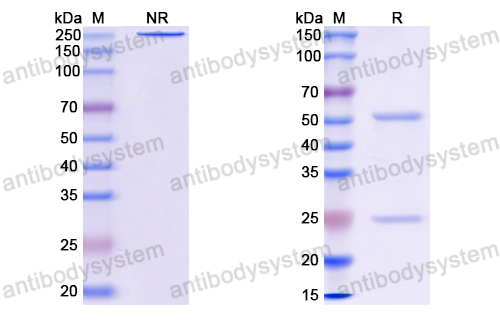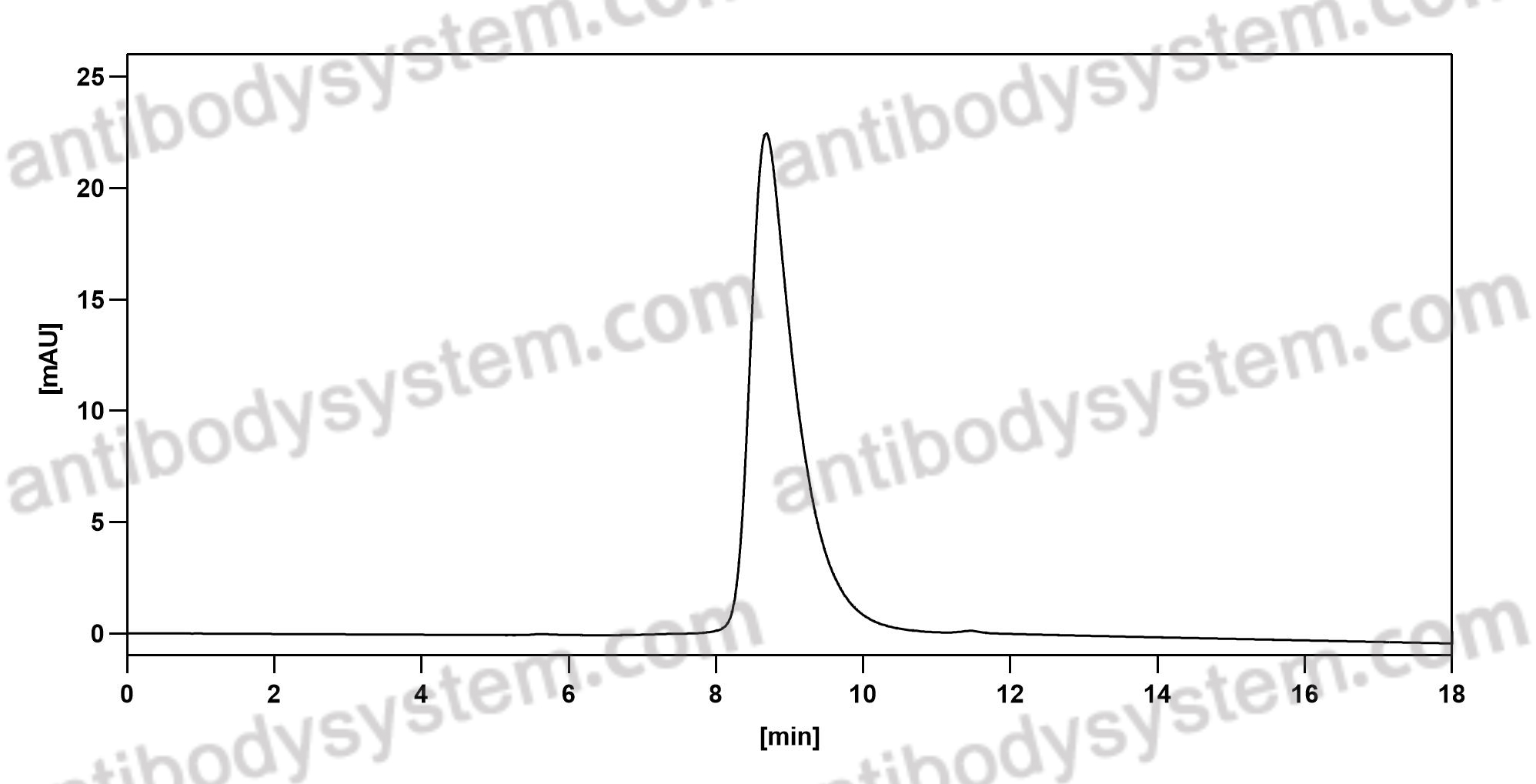The structural basis of herpesvirus entry. PMID: 33087881
Immunization with a self-assembling nanoparticle vaccine displaying EBV gH/gL protects humanized mice against lethal viral challenge. PMID: 35705092
Immunization with Components of the Viral Fusion Apparatus Elicits Antibodies That Neutralize Epstein-Barr Virus in B Cells and Epithelial Cells. PMID: 30979688
gH/gL supercomplexes at early stages of herpesvirus entry. PMID: 26849495
Epstein-Barr virus gH/gL has multiple sites of vulnerability for virus neutralization and fusion inhibition. PMID: 36306784
Epstein-Barr virus uses different complexes of glycoproteins gH and gL to infect B lymphocytes and epithelial cells. PMID: 9621012
Soluble Epstein-Barr virus glycoproteins gH, gL, and gp42 form a 1:1:1 stable complex that acts like soluble gp42 in B-cell fusion but not in epithelial cell fusion. PMID: 16973550
Functional analysis of glycoprotein L (gL) from rhesus lymphocryptovirus in Epstein-Barr virus-mediated cell fusion indicates a direct role of gL in gB-induced membrane fusion. PMID: 19457993
Structural and Mechanistic Insights into the Tropism of Epstein-Barr Virus. PMID: 27094060
Stuck in the middle: structural insights into the role of the gH/gL heterodimer in herpesvirus entry. PMID: 23107819
The large groove found in the gH/gL structure is an important functional domain for Epstein-Barr virus fusion. PMID: 23325693
Crystal structure of the Epstein-Barr virus (EBV) glycoprotein H/glycoprotein L (gH/gL) complex. PMID: 21149717
Functional homology of gHs and gLs from EBV-related gamma-herpesviruses for EBV-induced membrane fusion. PMID: 17477951
Epstein-Barr Virus Fusion with Epithelial Cells Triggered by gB Is Restricted by a gL Glycosylation Site. PMID: 28956769
Epstein-Barr virus gH is essential for penetration of B cells but also plays a role in attachment of virus to epithelial cells. PMID: 10864642
The KGD motif of Epstein-Barr virus gH/gL is bifunctional, orchestrating infection of B cells and epithelial cells. PMID: 22215569
The Epstein-Barr virus (EBV) BZLF2 gene product associates with the gH and gL homologs of EBV and carries an epitope critical to infection of B cells but not of epithelial cells. PMID: 7539502
The Cytoplasmic Tail Domain of Epstein-Barr Virus gH Regulates Membrane Fusion Activity through Altering gH Binding to gp42 and Epithelial Cell Attachment. PMID: 27935841
Plxdc family members are novel receptors for the rhesus monkey rhadinovirus (RRV). PMID: 33657166
Antibody Generation and Immunogenicity Analysis of EBV gp42 N-Terminal Region. PMID: 34960650
An Antibody Targeting the Fusion Machinery Neutralizes Dual-Tropic Infection and Defines a Site of Vulnerability on Epstein-Barr Virus. PMID: 29669253
Binding-site interactions between Epstein-Barr virus fusion proteins gp42 and gH/gL reveal a peptide that inhibits both epithelial and B-cell membrane fusion. PMID: 17581996
Inhibition of EBV-mediated membrane fusion by anti-gHgL antibodies. PMID: 28939750
Comparative Mutagenesis of Pseudorabies Virus and Epstein-Barr Virus gH Identifies a Structural Determinant within Domain III of gH Required for Surface Expression and Entry Function. PMID: 26656711
Immunoinformatic and systems biology approaches to predict and validate peptide vaccines against Epstein-Barr virus (EBV). PMID: 30679646
The conserved disulfide bond within domain II of Epstein-Barr virus gH has divergent roles in membrane fusion with epithelial cells and B cells. PMID: 25231307
The amino terminus of Epstein-Barr virus glycoprotein gH is important for fusion with epithelial and B cells. PMID: 16160168
Structure of Epstein-Barr virus glycoprotein 42 suggests a mechanism for triggering receptor-activated virus entry. PMID: 19217393
Cleavage and secretion of Epstein-Barr virus glycoprotein 42 promote membrane fusion with B lymphocytes. PMID: 19369343
Gammaherpesvirus entry and fusion: A tale how two human pathogenic viruses enter their host cells. PMID: 31439152
Cell-surface expression of a mutated Epstein-Barr virus glycoprotein B allows fusion independent of other viral proteins. PMID: 15583133
Assembly and architecture of the EBV B cell entry triggering complex. PMID: 25144748
Membrane anchoring of Epstein-Barr virus gp42 inhibits fusion with B cells even with increased flexibility allowed by engineered spacers. PMID: 25564465
The BDLF2 protein of Epstein-Barr virus is a type II glycosylated envelope protein whose processing is dependent on coexpression with the BMRF2 protein. PMID: 18995876
Coreceptor restriction within the HLA-DQ locus for Epstein-Barr virus infection. PMID: 10908662
Epstein-Barr virus entry utilizing HLA-DP or HLA-DQ as a coreceptor. PMID: 10666279
Alternate replication in B cells and epithelial cells switches tropism of Epstein-Barr virus. PMID: 12042810
Epstein-Barr virus infection of polarized epithelial cells via the basolateral surface by memory B cell-mediated transfer infection. PMID: 21573183
Epstein-Barr virus lacking glycoprotein gp42 can bind to B cells but is not able to infect. PMID: 9420211
Epstein-Barr virus uses HLA class II as a cofactor for infection of B lymphocytes. PMID: 9151859
Capacity of Epstein-Barr virus to infect monocytes and inhibit their development into dendritic cells is affected by the cell type supporting virus replication. PMID: 15448337
Eph Receptor Tyrosine Kinases Are Functional Entry Receptors for Murine Gammaherpesvirus 68., PMID:40501621
High IgG titers against EBV glycoprotein 42 correlate with lower risk of nasopharyngeal carcinoma., PMID:39959976
Association Between Antibodies That Bind Epstein-Barr Virus (EBV) gp350 and gH/gL and Shedding of EBV in Saliva From Nasopharyngeal Carcinoma Multiplex Family Members in Taiwan., PMID:39229285
A gH/gL-encoding replicon vaccine elicits neutralizing antibodies that protect humanized mice against EBV challenge., PMID:38926438
Vaccination with nanoparticles displaying gH/gL from Epstein-Barr virus elicits limited cross-protection against rhesus lymphocryptovirus., PMID:38781964
Epstein-Barr virus gp42 antibodies reveal sites of vulnerability for receptor binding and fusion to B cells., PMID:38479361
Urgency and necessity of Epstein-Barr virus prophylactic vaccines., PMID:36494369
Epstein-Barr virus gH/gL has multiple sites of vulnerability for virus neutralization and fusion inhibition., PMID:36306784
Immunization with a self-assembling nanoparticle vaccine displaying EBV gH/gL protects humanized mice against lethal viral challenge., PMID:35705092
Antibody Generation and Immunogenicity Analysis of EBV gp42 N-Terminal Region., PMID:34960650
Immunization with Components of the Viral Fusion Apparatus Elicits Antibodies That Neutralize Epstein-Barr Virus in B Cells and Epithelial Cells., PMID:30979688
An Antibody Targeting the Fusion Machinery Neutralizes Dual-Tropic Infection and Defines a Site of Vulnerability on Epstein-Barr Virus., PMID:29669253
Inhibition of EBV-mediated membrane fusion by anti-gHgL antibodies., PMID:28939750
Structural basis for potent antibody-mediated neutralization of human cytomegalovirus., PMID:28783665
Scanning Mutagenesis of Human Cytomegalovirus Glycoprotein gH/gL., PMID:26656708
Human Cytomegalovirus gH/gL/gO Promotes the Fusion Step of Entry into All Cell Types, whereas gH/gL/UL128-131 Broadens Virus Tropism through a Distinct Mechanism., PMID:26085146
Fusion of Epstein-Barr virus with epithelial cells can be triggered by αvβ5 in addition to αvβ6 and αvβ8, and integrin binding triggers a conformational change in glycoproteins gHgL., PMID:21957301
Structure of a core fragment of glycoprotein H from pseudorabies virus in complex with antibody., PMID:21149698
Point mutations in EBV gH that abrogate or differentially affect B cell and epithelial cell fusion., PMID:17307213
Cell-surface expression of a mutated Epstein-Barr virus glycoprotein B allows fusion independent of other viral proteins., PMID:15583133
Epstein-Barr virus gH is essential for penetration of B cells but also plays a role in attachment of virus to epithelial cells., PMID:10864642
Epstein-Barr virus lacking glycoprotein gp42 can bind to B cells but is not able to infect., PMID:9420211
Epstein-Barr virus uses HLA class II as a cofactor for infection of B lymphocytes., PMID:9151859
The Epstein-Barr virus (EBV) BZLF2 gene product associates with the gH and gL homologs of EBV and carries an epitope critical to infection of B cells but not of epithelial cells., PMID:7539502


